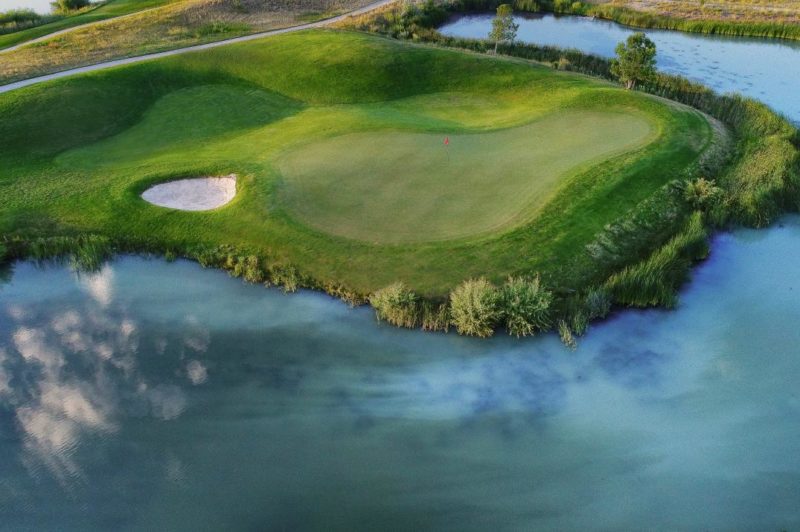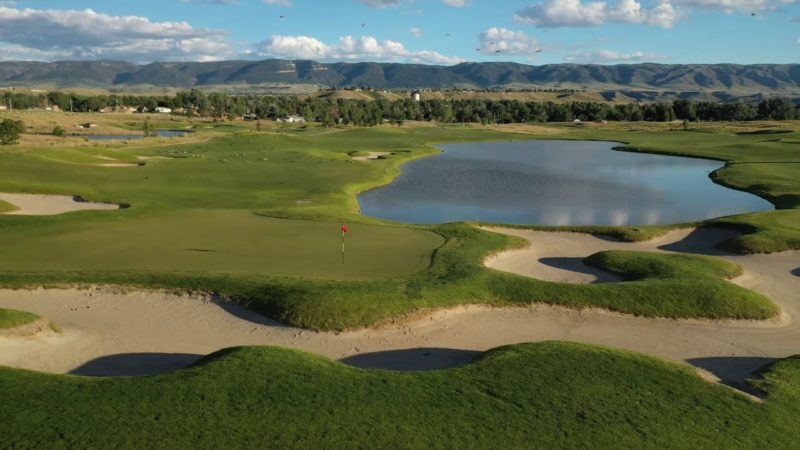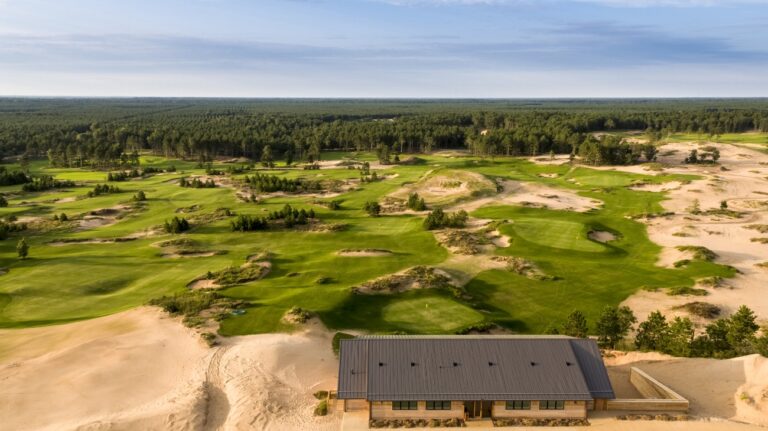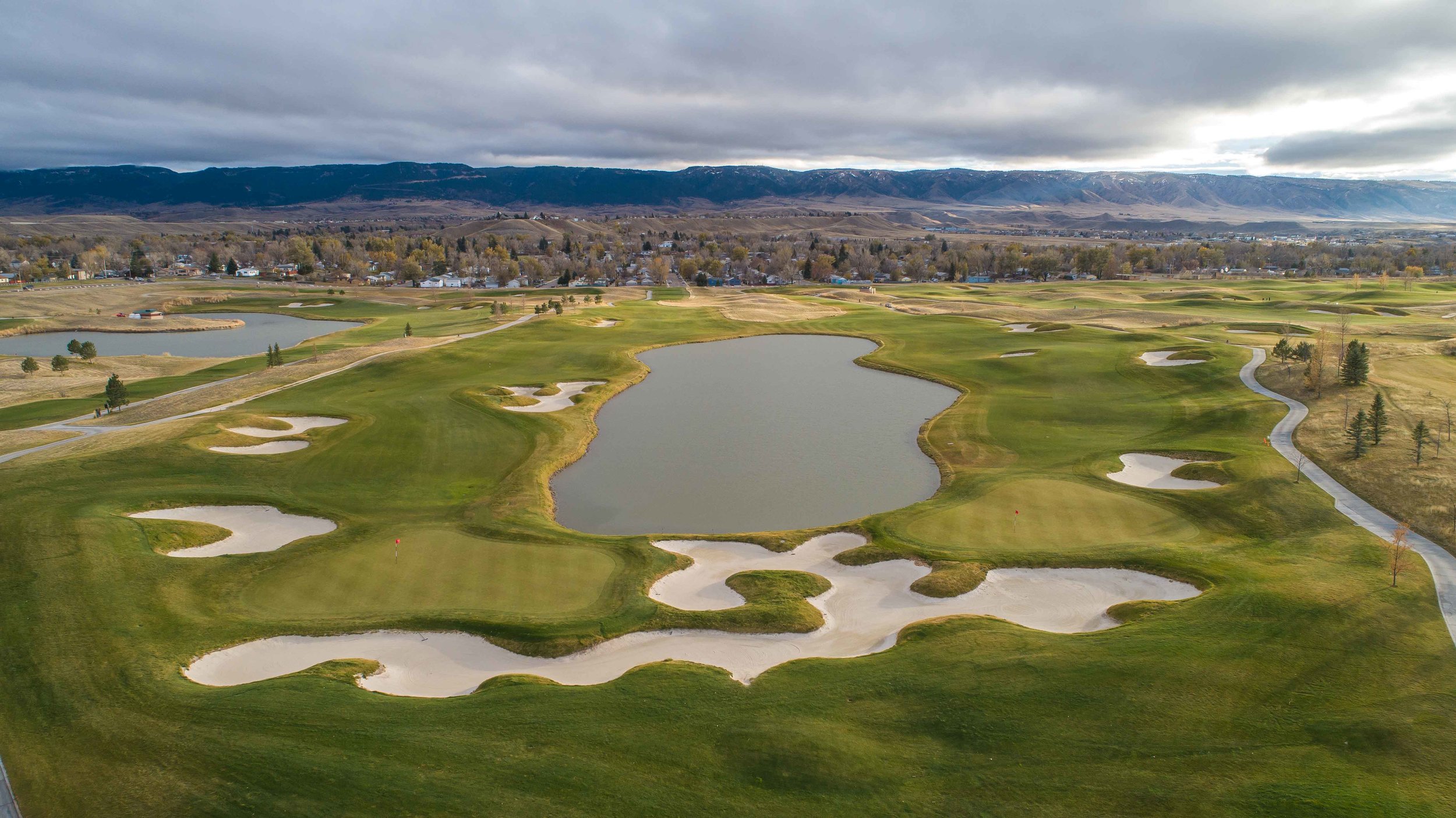Site of former refinery is now Casper’s best, and most beautiful, golf course
CASPER, Wyoming – Wyoming is America’s least populated state, and the city of Casper, with 59,000 residents, is one of its benchmark towns. Casper was built on the back of the energy business – especially oil and natural gas – and the city’s past, present, and future are directly linked to this vital industry.
Given that fact, it’s appropriate that Casper’s best golf course was built on the site of one of the region’s largest and longest-operating oil refineries. Smack dab in the middle of town, and directly adjacent to the North Platte River, lies Three Crowns Golf Club, an award-winning track and remediation project on the former Amoco Oil Refinery.
Where once there were tanks and towers and heat exchangers and thousands of miles of pipe, there is now a gleaming and green, par-72, 7,065-yard Robert Trent Jones, Jr.-designed course. The layout has 110 acres of manicured turf and 45 acres of native grasses. Eight lakes, four of which help remediate water pollution, come into play on 14 holes, and 84 bunkers filled with white sand punctuate the golfscape while adding challenges galore.
Three Crowns is named for BP Amoco’s old symbol – crowns of gold, white and red, which represent the three different grades of gasoline sold by the company. The golf course occupies land that still contains millions of gallons of refinery product scheduled for recovery over the next two decades.

The successful exploration and discovery of abundant oil reserves in Wyoming has been the driving force in the economy in the state for decades and led to the construction of the Midwest Oil Refinery in Casper in 1912. The facility is a significant part of the city’s history, but the condition of the property around the refinery and the runoff from it into the river was a health risk and a huge cause of concern for local residents.
The 340-acre site pumped and refined 48,000 barrels of oil a day for eight decades before Amoco announced the refinery would be closed. On December 13, 1991 – as stories grew of basements on the site filled waist-deep with oil leeching from the ground – the last barrel of gasoline was refined, and the site was shut down. It took eight years before the Wyoming Department of Environmental Quality signed a consent decree with the corporation to establish a framework for cleanup of the property. The site, now known as Platte River Commons, includes the golf course, a burgeoning business park, jogging trails, and riverside parks.
The department then went to work with the entire Casper community and identified an environmentally safe reuse of the land. It was quite an undertaking as over the years close to 300 million gallons of oil had spilled onto the site.
One of Jones, Jr.’s biggest challenges in designing Three Crowns was adjusting to the requirement that cuts could not be made deeper than six feet. In preparing the site, 3,000 miles of pipe and 400,000 cubic yards of concrete were removed, and contaminated soil was capped with 6 feet of clean dirt. Landowner BP Products North America, which had merged with Amoco, then installed a remediation system; an intricate arrangement of pumps, oil separators, monitoring and recovery wells and other technology is integrated across the course to treat and test all water, ensuring that it meets environmental standards before it is returned to the North Platte River.
Using high-tech maps that identified places where the soil was uncontaminated at lower depths, Jones’ construction team dug lakes (which they lined with geotechnical fiber to keep out contamination) and used the excavated dirt to build mounds and other features around the course.
The mounds separate the golf holes from each other, lend an isolated feel to the course and are covered in native grasses that turn wheat-colored in summer to beautifully set off the verdant fairways.

There are more than 120 recovery wells working at Three Crowns GC, many on the footprint of the golf course. They produce not only oil (about 30 barrels a day are still taken out of the ground), but water as well. Jones incorporated the water-remediation process into the design.
And what a job the RTJ team did. Opened in 2005 with much fanfare, Three Crowns Golf Club is a jewel to play and a tough course for anyone. The track crosses the old rolling refinery site with a combination of long par 3s (all at least 200 yards), monster par 5s (three are 575 yards or longer) and a collection of mostly short par-4s (the longest of which is just 425 yards).
The front nine, played in a 3-3-3 sequence of one-, two and three-shotters, is highlighted by the 595-yard par-5 second, which doglegs right around a huge pond to the second-smallest green on the course. Played as the No. 1 handicap hole, you must avoid bunkers at the landing site – the prime lay-up spot – and around the putting surface.
The fourth hole is the hardest of the five par 3s at Three Crowns, and at 210 yards and requiring a complete carry of the water that runs from tee to green, is one of its real beauties. Try to get a stroke back at the 515-yard par-5 ninth but be wary of the huge bunkers that narrow the fairway and sit behind the green.
No. 10 is another place where you might claim a birdie, but any shot short and left of the putting surface on this 525-yard par 5 might catch the high grass that separates the fairway from the lake or the bunker that waits in the lurch.
The 13th is Three Crowns’ longest par 4 and is made more difficult by a tapered gap near the green, water on the port side and the rear, and sand to the starboard. No. 15 brings strategy into play by way of a creek that slices across the fairway at the optimal landing area, after which the hole turns slightly to the right and uphill to a small and shallow putting surface.
Grip it and rip it on the 600-yard, par-5 17th as it will take three really good shots to reach the elevated green in regulation. That sets the stage for the closer, a 415-yard par-4 with a huge round bunker in the middle of the fairway. It will take a 270-yard blast to carry this maw on the fly, so it’s best to steer left and away from the right, which is a shorter route but slopes hard toward the water that runs all the way up past the green.
Three Crowns and Casper sit at about 5,150 feet elevation, so take that into consideration when selecting clubs. And because the wind frequently roars out of the mountains to the west, expect some weather changes as well.
The greens at Three Crowns are A-1 Bentgrass surfaces, and Kentucky Bluegrass carpets the tees, fairways, and roughs. A 13-acre practice facility with a practice green, two bunkers, short-game area and 300-yard driving range provide golfers an excellent opportunity to warm up before the round.
Check out www.threecrownsgolfclub.com for stunning before-and-after photos of the course. If you’re ever in Wyoming – tourism is one of the top economic engines in the state – make it a point to stop and play Three Crowns Golf Club.











